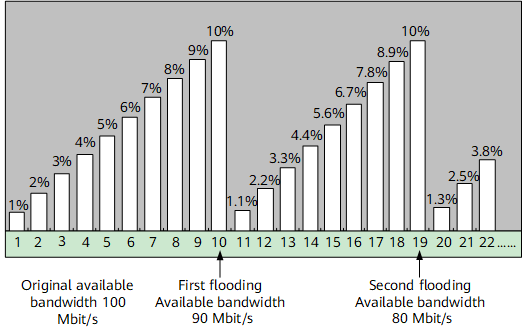Information Advertisement Component
The information advertisement component is used to advertise network resource information to all nodes, including ingresses, on an MPLS TE network, to determine the paths and nodes that MPLS TE tunnels pass through. In this way, TE can be implemented to control network traffic distribution, improving network resource utilization.
Related Concepts
Concept |
Description |
|---|---|
Total link bandwidth |
Total bandwidth of a physical link, which is manually configured. |
Maximum reservable bandwidth |
Maximum bandwidth that a link can reserve for an MPLS TE tunnel. The maximum reservable bandwidth must be lower than or equal to the total bandwidth of the link. Manually configure the maximum bandwidth according to the bandwidth usage of the link when using MPLS TE. |
TE metric |
A TE metric is used in TE tunnel path calculation, allowing the calculation process to be independent from IGP route-based path calculation. By default, the IGP metric is used as the TE metric. |
SRLG |
A shared risk link group (SRLG) is a set of links that share a common physical resource (such as a fiber). Links in an SRLG are at the same risk of faults. Specifically, if one of the links fails, other links in the SRLG also fail. SRLG is mainly used in hot-standby CR-LSP and TE FRR scenarios to enhance TE tunnel reliability. For details about SRLG, see SRLG. |
Link administrative group |
A link administrative group, also called a link color, is a 128-bit vector. Each bit can be associated or not with a desired meaning, such as link bandwidth, a performance parameter (such as the delay), or a management policy. The policy can be a traffic type (multicast for example) or a flag indicating that a link is used by an MPLS TE tunnel. The link administrative group attribute is used together with affinities to control the paths for tunnels. |
Contents to Be Advertised
Link status information: interface IP addresses, link types, and link metric values, which are collected by an IGP
Bandwidth information, such as total link bandwidth and maximum reservable bandwidth
TE metric: TE link metric, which is the same as the IGP metric by default
Link administrative group
SRLG
Advertisement Methods
When to Advertise Information
OSPF TE or IS-IS TE floods link information so that each node can save area-wide link information to a traffic engineering database (TEDB). Information flooding is triggered by the establishment of an MPLS TE tunnel, or one of the following conditions:
A specific IGP TE flooding interval elapses.
A link is activated or deactivated.
A CR-LSP fails to be established for an MPLS TE tunnel because no adequate bandwidth can be reserved.
Link attributes, such as the administrative group attribute or affinity attribute, change.
The link bandwidth changes.
When the available bandwidth of an MPLS interface changes, the system automatically updates information in the TEDB and floods it. When a lot of tunnels are to be established on a node, the node reserves bandwidth and frequently updates information in the TEDB and floods it. For example, the bandwidth of a link is 100 Mbit/s. If 100 TE tunnels, each with bandwidth of 1 Mbit/s, are established, the system floods link information 100 times.
To help suppress the frequency at which TEDB information is updated and flooded, the flooding is triggered based on either of the following conditions:
The proportion of the bandwidth reserved for an MPLS TE tunnel to the available bandwidth in the TEDB is greater than or equal to a specific threshold.
The proportion of the bandwidth released by an MPLS TE tunnel to the available bandwidth in the TEDB is greater than or equal to a specific threshold.
If either of the preceding conditions is met, an IGP floods link bandwidth information, and CSPF updates the TEDB.
Assume that the available bandwidth of a link is 100 Mbit/s and 100 TE tunnels, each with bandwidth of 1 Mbit/s, are established over the link. The flooding threshold is 10%. Figure 1 shows the proportion of the bandwidth reserved for each MPLS TE tunnel to the available bandwidth in the TEDB.
Bandwidth flooding is not performed when tunnels 1 to 9 are created. After tunnel 10 is created, the bandwidth information (10 Mbit/s in total) on tunnels 1 to 10 is flooded. The available bandwidth is 90 Mbit/s. Similarly, no bandwidth information is flooded after tunnels 11 to 18 are created. After tunnel 19 is created, bandwidth information of tunnels 11 to 19 is flooded. The process repeats until tunnel 100 is established.
Results Obtained After Information Advertisement
Every node creates a TEDB in an MPLS TE area after OSPF TE or IS-IS TE floods bandwidth information.
TE parameters are advertised during the deployment of an MPLS TE network. Every node collects TE link information in the MPLS TE area and saves it in a TEDB. The TEDB
contains network link and topology attributes, including information about the constraints and bandwidth usage of each link. A node calculates the optimal path to another node in the MPLS TE area based on information in the TEDB. MPLS TE then establishes a CR-LSP over this optimal path.
- Similarities: The two types of databases both collect routing information flooded by IGPs.
- Differences: A TEDB contains TE information in addition to all the information in an LSDB. An IGP uses information in an LSDB to calculate the shortest path, while MPLS TE uses information in a TEDB to calculate the optimal path.
